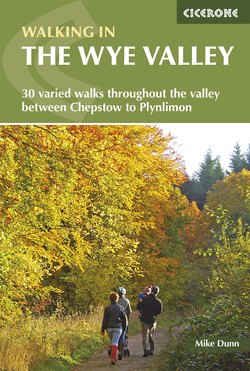Читать книгу Walking in the Wye Valley - Mike Dunn - Страница 11
На сайте Литреса книга снята с продажи.
ОглавлениеWALK 1
The Lancaut Peninsula
| Start/Finish | Rising Sun pub, Woodcroft (ST 542 957) |
| Distance | 5km (3 miles) |
| Ascent | 110m (360ft) |
| Time | 2hrs |
| Map | Outdoor Leisure 14 |
| Public transport | Woodcroft has no public transport services useful for walkers |
| Parking | Roadside parking in Woodcroft |
This is a short walk but one full of interest, with a sharp descent into the Wye Gorge, a visit to the ruined church at Lancaut, and a climb past an Iron Age fort and Offa’s Dyke to the well-known viewpoint of Wintour’s Leap.
Take the B4228 south from the Rising Sun (which has a chequered recent history and may be closed) in Woodcroft, passing the arched entrance to Moyle Old School Lane and then turning right onto a stony path (signposted as Offa’s Dyke Path) enclosed between railings and a high stone wall. When the long-distance trail goes left through a kissing gate, go straight on under a little wooden footbridge to enter Lancaut Nature Reserve, now with the Wye Gorge dramatically down to the left. The well-defined path begins to drop steeply through mixed woodland, guided by red waymarkers and with massive limestone cliffs (used as nest sites by peregrine falcons) rising 90m (300ft) up to the right.
The Lancaut and Ban-y-Gor nature reserves were established in 1971 and comprise superb woodlands with oak, ash, yew and lime, together with rare whitebeams, with birdlife ranging from peregrines and ravens on the cliffs to wood warblers and goldcrests in the woods and shelduck and cormorants on the river. Dormice and the unusual lapidary snail inhabit the woodlands, while the riverine saltmarsh supports sea aster and English scurvy-grass.
The path levels out, drops steeply again and reaches an area of big, awkward boulders, which can be troublesome for the next 50m, although the best route is indicated by yellow paint splashes. The hill slope above is strewn with boulders and a gap in the limestone cliffs on the skyline emphasises the damage caused by illegal quarrying here. On the far side of the boulders the path rises and falls through woodland before reaching a wooden bench with an excellent view downstream along the Wye, muddy and tidal here as it nears its confluence with the Severn.
St James’s Church is all that remains of the abandoned village of Lancaut
Keep to the riverside path as it curves around a big meander, with Walter’s Weir ahead a reminder of the former importance of the river fisheries here. When the stark, roofless ruins of St James’s Church suddenly loom above the path, clamber up to the right to inspect the church, which was founded in the seventh century but abandoned in 1865. The remains are melancholy but the setting above the river is superb, with a partly collapsed Norman chancel arch, gravestones propped up against the west wall and the base of the churchyard cross still visible. The Crown Estate sold the church to the Forest of Dean Buildings Trust for just £1 in 2014, but it will cost the Trust another £50,000 to stabilise the ruins.
The fields by St James’s Church conceal the remains of the deserted village of Lancaut. The village was always small, with a maximum of 19 households recorded, but by 1750 it had only two inhabited dwellings – one of them the surviving Lancaut Farm – together with a cottage and fish-house below the church, which were abandoned in the early 1800s. The peninsula also housed a leper colony, although all traces of this have been lost.
The route now lies steeply up the hillside, still following the red waymarks and at first clambering up a flight of wooden steps before zigzagging through coppiced woodland, carpeted with anemones in spring, past two derelict limekilns to reach the metalled road leading to Lancaut Farm. (Slightly to the left a thin path used by climbers to reach the top of the Ban-y-Gor rocks snakes away to the north; it is worth following this for 100m or so to enjoy the spectacular views northwards along the Wye Gorge, but the path then runs above precipitous slopes and is not for the faint-hearted.) The main route lies to the right, passing the low bank defining the western boundary of the Spital Meend hillfort – a typical Iron Age promontory fort with low banks and ditches.
As the lane passes through the eastern boundary of the hillfort, again marked by a low bank and ditch, it becomes walled and starts to run downhill. The eastern rampart of the hillfort was re-used in the eighth century when Offa’s Dyke was constructed here. A short section here is surprisingly suburban in nature, although there are still glimpses of the extraordinary limestone cliffs below Wintour’s Leap. Go right at the main road, following this or an adjacent informal path around a tight bend and then going a few steps right to reach the Wintour’s Leap viewpoint. The royalist Sir John Wintour allegedly eluded his Parliamentarian pursuers in 1642 by leaping from the vertical cliffs here, although it is more likely he escaped using a less spectacular route further upstream.
The Lancaut peninsula from the rocks of Wintour’s Leap
Take the footpath angling off to the right, signposted as Offa’s Dyke Path, with more views of the Wye Gorge to the right and, as the houses thin out, the broad River Severn away to the left. Beyond the enormous Woodcroft Quarry turn left by a cottage, taking a broad track down to the main road and turning right to return to the start of the walk in Woodcroft.
